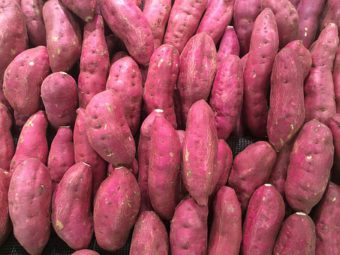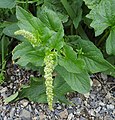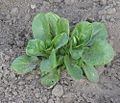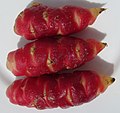In this article on the growing of non-standard vegetables in containers will be broached. In previous articles, I have discussed traditional vegetables such as potatoes, tomatoes, aubergines, chilies, beans, etc in containers.
This group often appear in plant and seed catalogues, and in online seed companies. All the favourites are found here but some like kohlrabi and scorzonera are not often found in the container vegetable garden. They have been in catalogues for a long time but they are not classed as non-standard vegetables. They may not be liked but it does not make them rare.

There is now a host of vegetables suitable to grow in your container garden. These are often not normally found in your seed catalogue and hence why they are known as non-standard vegetables. Salads leaves have been discussed in a past article whilst oriental vegetables will be discussed in an article in the near future.
The role of celebrity chefs has made once what was obscure to the forefront in the kitchen. This is what will be discussed in this article, both popular varieties and rarities, age-old vegetables and the product of plant breeding in the 20th and 21st centuries:
ABYSSINIAN CABBAGE
This member of the cabbage family was discovered as a field crop in Ethiopia in 1957. The variety Texsel was developed in Texas as a new variety of a new vegetable. It is not a popular vegetable despite it having several virtues of being quick growing, and its excellent cut and come again nature. The young and mature leaves are tender enough to be eaten raw, so makes an excellent salad ingredient.

The leaves can be cooked in a similar way to spring cabbage, whilst the flower heads can be cooked in a similar way to broccoli.
Grow this versatile vegetable in a large container full of multipurpose compost in full sun. If you are looking for it search for Texsel green as it is the easiest to find.
BUCK’S-HORN PLANTAIN
This is a native plant to the UK, where in coastal areas it is a major weed. The cultivated form looks similar, although they have been bred to have larger leaves. These fleshy leaves are what the plant has been bred for, as the leaves can be eaten raw in salads or cooked to form a vegetable side-dish.

Not easy to find but if you look hard you can find an online supplier. It may be hard to find but it is easy to grow. You can sow thinly in shallow drills in large pots full of multipurpose compost in April to June. Do not cover the seeds, thin once the seedling emerges. Dense clumps are produced, where it is best to harvest the narrow feathery leaves before they are fully grown.
DANDELION
Dandelions are such an unusual vegetable to be grown. Just imagine a weed as a salad ingredient, where instead of growing in the lawn or in flower beds, they can be grown in a controlled manner in containers.
It has been used as a vegetable since medieval times, where the leaves need to be blanched to provide succulent leaves. The blanching is carried out by excluding light completely from the plant. You need to buy a variety that has been specially bred to produce the large leaves that are used in your dishes.
Sow the seeds in a large container full of multipurpose compost, where in the first year the seeds and the plants are allowed to develop. In the spring in the following year cover each plant with a pot that light cannot penetrate. 10 days later the leaves will be white and then can be eaten.
GOOD KING HENRY
This is an old traditional vegetable that was used in medieval times. It is a perennial that grows up to 60cm in height.

Sow the seeds in April in a very large pot of multipurpose compost. As the seeds emerge thin to one plant per pot. You need to sow directly as they do not transplant too well. The key is not to expect too much in the first year, as you need for the plant to develop. Cut down the plant in autumn, where the crown needs to be covered with leaf mould or compost.
Cropping can then begin in the following spring, where new shoots are cooked like asparagus. This can be done between April and June. After June, you should stop cutting back and allow the new shoots to develop. The triangular leaves can be picked a few at a time until August, where they can be cooked like spinach. It is best to grow about 4 to 6 containers for a decent crop.
HAMBURG PARSLEY
A vegetable whose leaves can be used exactly the same way as parsley which the long taproot has a taste like parsnip with a hint of celery. You need to grow in a wide and tall container full of multipurpose compost where in November the roots are ready for lifting.
At this stage, it will be 20+cm long but you can leave them in the ground over winter. To harvest them, lift them from the container and store them in a similar way to that of parsnip.
Once lifted remove the stalk and scrub the roots. Do not peel as this will spoil the subtle flavor. You can cook it the same way as parsnip but the best way is to roast them or fry them like chips.
LAMB’S LETTUCE
Normally lettuce is seen everywhere in summer but Lamb’s lettuce is hardly seen. It has advantages over lettuce is that the small leaves can be picked outdoors between November and January. This is where vegetable pickings are non-existent.

Sow in August to September in pots full of multipurpose compost, where the thinnings can be used in the kitchen in salads.
During winter pick a few leaves from each plant, leaving the rest to grow on. The leaves need to be washed thoroughly to remove any pests or grit. Use it as a substitute for lettuce but if you find it to be too bitter, you can blanch it for a few days before using the leaves.
NASTURTIUMS
This flowering plant was once consumed frequently but it has declined in recent year. The leaves have a peppery taste, similar to watercress, where it mixes well with lettuce leaves. You can directly plant the seeds in multipurpose compost.

They prefer to be grown in compost where no fertilizer has been added. Pick the leaves young where it is ideal in salads and sandwiches. The flowers are not so much flavor but can be used in a similar way. The seeds are used as a substitute for capers.
NEW ZEALAND YAM
This is alternatively known as South American oca, which is a tuber producing plant from the Andes. It is an old-time vegetable and has been grown in the UK for over 200 years. Its common name comes about as it is an established vegetable in New Zealand.

They are not similar to potatoes, as they have many differences. They are planted in June and do not need to be earthed up. To get the maximum yield plant in a large 50 litres pots full of enriched multipurpose compost.
Once harvested the tubers can be eaten raw in salads or they can be baked, boiled, or fried, just like potatoes.
The shamrock-shaped leaves can be used as a salad ingredient.
OKRA (Lady’s Fingers)
This vegetable so familiar in Caribbean dishes can be found in oriental supermarkets but not much so in UK gardens. It is best to treat it as a greenhouse crop, where it can be grown in exactly the same way you would grow a tomato crop in the greenhouse.

Soak the seeds overnight before sowing in large pots full of multipurpose compost. When the stems reach 20cm tall pinch out the growing tips. Feed with a high potash liquid fertilizer to promote pod production, where they should be picked when they reach 8cm long.
ORACHE (Mountain Spinach)
Very difficult to find as you need to go for an online seed supplier hunt. Hard to find but easy to grow. The beauty of the vegetable is that it comes in many colours from green, purple, red, or golden yellow.

This will look stunning in pots, where the young leaves will add colour to salads. The larger, more mature leaves can be cooked in a similar way to spinach.
Sow in large containers of multipurpose compost in full sun in May, where you will be harvesting in the summer months.
SEA KALE
This cannot be bought as a seed but instead as a crown. You will need to rub off all growing buds bar one when planting each crown.
Grow in a large container full of multipurpose compost, one crown per container. You will need to plant each crown below the compost level, to prevent it from rotting.

In autumn cut down the yellow leaves and cover the crown with compost mulch for winter protection. In November each plant is covered with a pot to provide insulation.
Once the stems are 20cm long, you can cook it like asparagus. This normally occurs in April. After this cover with mulch and allow the plant to develop normally to build reserves for the rest of the growing year. You will need to blanch in a similar way to dandelion leaves but the biggest advantage with this vegetable is that you can blanch it year after year.
SORREL
This classic French vegetable is a basic ingredient for many recipes. It is a perennial that is propagated by seeds sown in April, where it will be happily grown in containers full of multipurpose compost.

An easy plant as it does not take much looking after, only watering in dry weather and removal of flower heads as they appear. You can harvest leaves between March and November, where you should remove some leaves from each plant, as soon as they are big enough. Small leaves are less bitter, whilst extremely large leaves are too bitter for some.
SWEET POTATOES
This vegetable is not readily grown in the UK, unlike our American cousins. The British tend to find the tubers too sweet to eat with our savoury and meat dishes. It is actually tastier to roast them, where the tubers are scrubbed (Not peeled) and then placed in aluminium foil with a little salt, a bit of pepper, and a lot of butter. Excellent with pork or turkey.

Best to plant slips (tuber cuttings) deeps in a tall and wide container (at least 50 litres or more). The bigger the container the better, where you can plant 2 to 3 slips per container. The container needs to be filled with enriched multipurpose compost, where the planted tubers form on the trailing stem, where they can be harvested as when required. Do not cook straight away as it needs to ‘sweeten up’, so cook after one week has elapsed.
TOMATILLO
This plant has a tomato-like flavour with a hint of lime, but despite its common name, it is no relation to the tomato. In fact, it is more related to Cape gooseberry, where it has so many used in Mexican cuisine.

The fruit when ripe can be green, purple yellow or even red, which is encased in a paper-like lantern. To be at its best, it needs to be grown in a greenhouse or against a south-facing wall.
Sow seeds in February or March where it can be grown exactly the same way as tomatoes. Plant it in a large container full of multipurpose compost in full sun. It is a tall plant with many branches and so will need to be supported.
You will need several varieties to get a decent crop as cross-pollination can be a problem.
The taste is an acquired one but if you like it, you can grow it and used it in salads, salsas, and sauces.
CONCLUSIONS
In this article growing non-standard vegetables in containers have been discussed. These are not the usual varieties often found growing up and down the country, but vegetables that are not often grown.
As you can see there are a number of varieties that can be used to give more distinct flavours to your dinner plate.
If you are more daring you should give these vegetables a try.
If you have a question to ask or a comment that you need to make, please do so in the comment box below.
Happy Eating.

I love sweet potatoes and the idea of plating some in a container is really awesome for me. But how do I measure the container? I know that sweet potato is a rampant plant and that you can not really predict how many potatoes you can get and if the container will be enough. So, how can I measure that? And how deep should be the container?
Thanks
Hi Adyns
it is always a puzzle to what size to use for a trailing plant but for sweet potatoes, I would use 50 litre or above containers, which should be greater than 40cm in diameter and height. If you feed regularly, water regularly you should get a bumper crop. In containers, they should not be as rampant.
Why don’t you give it a try next year?
Thanks
Antonio
Wow, I didn’t know that tbis vegetables can actually be grown in a container. I usually buy okra and sweet potatoes and they are regulars in my home delicacies. I also make use of lettuce. This is good and I like the fact that you added was to plant this non standard vegetables. This is an eye opener. Thank you for this educative post.
Hi Henderson
It is always amazing what can be grown in containers but this is so dependent on which country you reside in. Hot countries will give you a large scope of vegetables that can be grown, whilst with cold countries, you have to grow the same veg but in a smaller timeframe. A challenge but not impossible, if you are willing to give a try.
Will you?
Antonio
Thanks for the list of the other non standard vegetables that can be grown in a container gardening. Though I am a seasoned gardener but I have never for once tried to plant any other than the standard vegetables in my garden. This seem more like a challenge, which I am ready to take up. You have suggested some great plants to grow too and I think I might give a couple of them a trial. I like okra so, definitely it would be among the list of plants I will try out.
Hi Ramos
it is always good to challenge oneself to grow more difficult veg that we would not normally grow. I always say if you do not try, how do you know if you will fail or succeed. Give a go next year.
Thanks Antonio
How nice to read an article of yours again with so much vegetable growing information. As I have said before in the vegetable garden I keep in my village, I grow vegetables. These new species that you mentioned impressed me, as did the crop style. In particular, I would love to start with sweet potatoes, which we all love. Also the vegetables Hamburg Parsley, Orache, Sea Kale look amazing ideas. I have never heard of it here in Greece. Where could I get it? Thanks a lot for your ideas and great article.
Hi Water Life
This is why I do not recommend seed suppliers because this will change from country to country and space on my website will not allow me to go through each country highlighting where you can buy seeds. What I normally recommend is getting in contact with your local supplier and asking them if they can get hold of the seed. if they don’t have it, they will probably know some who do. I do not like to avoid answering your question but But I cannot know the seed suppliers in every country, as the seeds on offer changes so much.
Thank you
Antonio
What would you advice: growing more than one non-standard vegetables in a container or one vegetable per container? It has never crossed my mind to consider growing sweet potatoes in a container as most of them that I’ve seen in my locality grows very big. Can you do me a favour by writing on containers considered as an ideal size for growing most of these vegetables?
Things will be clearer for me when figures or dimensions are given. Thanks for the information
Hi DerrAd
The problem with container size is that it is difficult to get right, as it depends on so many variables. I am just writing an article about the minimum size that containers need to be and this explains why you cannot give a definitive answer. Sweet potatoes can be grown in containers but you will need a big container that is why I recommend at least 50 litres or more if you can manage it..A 50 litre container will have a diameter of at least 40cm and a height of 40 cm as well. You have to match the container size to your own growing conditions. and experience, as I can only guide without being totally accurate.
Thanks
Antonio
Very nice and informative article about growing non-standard vegetables. I have been growing so called normal vegetables but it seems that these can be grown, harvested and used for nutrition in pretty much the same way. Especially I found sweet potatoes and tomatillo as interesting and these two could fit perfectly for my Mexican style cuisines.
Hi Jessetoillanen
It is always good to expand your palate and try to grow things you would not normally grow. You never know you may succeed instead of failing.
Good Luck
Antonio
Hello.Excellent article.Thank you for sharing with us this nice information.I had no Idea if non-standard vegetables can be grown in the containers and still grow well.I like gardening but I have no enough knowledge on how can I start gardening.Hope through the informations in your articles I can make it.I have bookmarked your website waiting to see your next articles.Wish you all the best.
Baraka.
Hi Baraka
That is what my website is about from taking novices to become proficient and for everybody to improve on their container gardening skills.
Thank you for stopping by.
Antonio
I’d like to ask, how big or large the container will be for these non-standard vegetables? Some of the crops mentioned are growing to a height equivalent to a person’s height, like for example, Okra. What would be the suggested dimension of the container?
For crops like these, I wonder if they can survive the UK’s winter season especially the tropical plants. But since they will be planted in containers, then you have the freedom to bring the plant inside a house in case there’s a severe winter coming.
Hi Gomer
Thank you for dropping by. For tall plants, I would recommend a container than is at least 25 litres but for root veg like oca and sweet potatoes, I would recommend 50 litres or more. The bigger the better, as you are more likely to benefit from the extra growing room. Okra will be grown as an annual crop here in the Uk, so no need to worry about bringing it in, as you will have to re-sow every year. Veg grows in the Uk are used to doing an annula sowing of veg and so this will not be a burden.
Thanks
Antonio